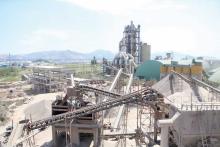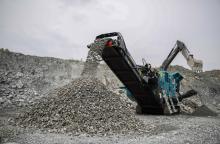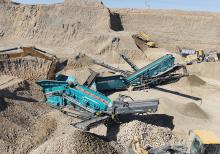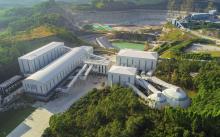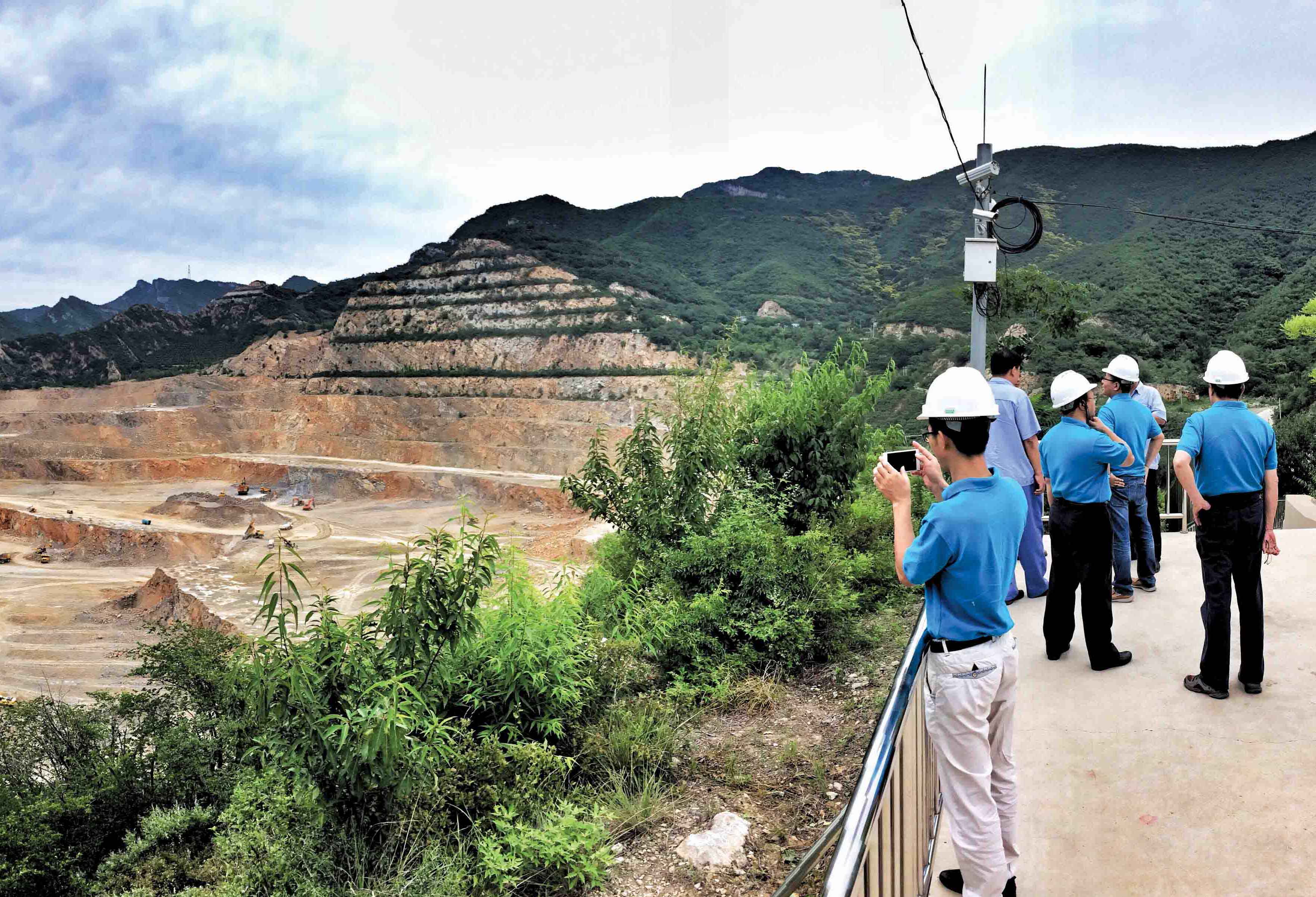
China’s aggregates demand is significantly down on past peaks. With the market for quarrying and construction increasingly export-driven,equipment manufacturers are talking about the “new reality” of the Chinese market. So what next for the world’s biggest consumer of aggregates? Guy Woodford reports.
China accounted for half of all new worldwide aggregates demand in the period 2010-2015, according to the renowned US-based business market research firm, The
From 1979 to 2010 China’s annual GDP growth was 9.91%, according to International Monetary Fund (IMF) figures. Such impressive growth was the envy of the world. By 2015, GDP growth had dropped to 6.9%, with industries, including the aggregates sector, feeling the effects.
According to David Zhao and his team at China Aggregates Net, which specialises in independent Chinese aggregates market analysis and statistics, aggregates-related equipment manufacturers are experiencing a “death match”-like market. “Overall aggregates demand may be down 20-30% in 2016,” says Zhao. “The speed of Chinese real estate investment was way down in 2015, while in 2016 the figure looks better. The inventory of houses has kept going up rapidly in the past 10 years, and existing houses will take eight years to sell, and that’s based on the best recent sales year, which was in 2014.”
Zhao says infrastructure construction is playing an increasingly large role in China aggregates demand. He notes that according to the Middle and Long Term Railway Plan 2016-2025 issued by the Chinese government, China will build 54,000kms of railway, including 19,000km of high speed railway. As stated in the government’s plan to develop transportation in the country’s poor areas, there will be 16,000kms of national high way and 46,000kms of national road being built in and around those locations. Furthermore, there is another 31,600kms of common road due to be constructed to assist transport links between the most deprived parts of China.
The Chinese government, adds Zhao, will also be continuing its part in the delivery of the One Belt One Road project, also known as The Silk Road Economic Belt and the 21st-century Maritime Silk Road. Encompassing around 60 countries, the US$4 trillion plus mega project of all mega projects, aims to significantly improve land and waterway connectivity and cooperation among countries, primarily between China and the rest of Eurasia.
“There are also new standards guiding China’s aggregates industry,” continues Zhao. “These include design specifications for manufactured sand and aggregates factories; standards for making bricks with recycled aggregates; and standards for permeable concrete made by recycled aggregates. There’s also a new standard of aggregates for making high performance concrete.”
China Aggregates Net recently reported on how aggregate producers will need to heed new tougher on-road truck transport regulations in China that came into force on September 21 2016.
According to the new regulation, introduced by the Ministry of Transportation of China to help reduce the high number of national road accidents caused by overloaded trucks, the overall weight of a truck with its cargo cannot exceed 49tonnes. If exceeded, the driver must pay a fine and lose a number of license credits. The same regulation has specified a maximum on-road freight truck length of 18.1m, a maximum truck width of 2.55m, and a top height of 4m. Zhao says that the average aggregates freight cost is likely to rise by at least 33.6% in order for aggregate and sand producers to comply with the tougher regulation.
Zhao adds: “The new regulation will have an effect on all construction material industries, including aggregates, cement, concrete and asphalt. All these industries have had very serious problems linked to overloaded transportation.”
The relative depression currently being experienced within the Chinese aggregates industry is, unsurprisingly, mirrored in Chinese construction and quarrying equipment demand. Huge infrastructure development programmes in China were key to huge construction machine sales totalling US$102 billion in 2011, according to David Phillips, managing director of Off Highway Research. The Chinese government decision to significantly reduce infrastructure spending has been, Phillips argues, the biggest factor behind global construction equipment sales falling to $78 billion in 2015, and to an estimated $72 billion in 2016.
Phillips notes how Chinese manufacturers are having to cope with over-capacity. Having built some 220,000 wheeled loaders in 2011, Phillips said he believes the Chinese market will account for around 50,000 wheeled loaders for the next few years. Similarly, he said that in 2011 Chinese firms built around 160,000 excavators, but the market will account for around 35,000 units over the next few years. The Chinese firms developed the capacity to build over 250,000 wheeled loaders/year, in excess of the total world demand for these machines of some 114,450 units. And for excavators Chinese firms developed the capacity to make some 430,000 units/year, compared with global sales of 354,062 units. Phillips stresses that Chinese manufacturers have taken steps to reduce production. But there is still excess capacity, particularly for wheeled loaders, while manufacturers also have to contend with a large pool of second-hand machines that have clocked low hours, providing attractive deals for customers looking to replace old units. Phillips does not see mergers and acquisitions being a major factor and he is also certain that the key manufacturers have a strong future.
One of those 10 key Chinese manufacturers referred to by Phillips is Liuzhou-headquartered
“Over the last few years we have seen China’s economy change from a rapid growth phase to a slower, sustained level of growth. The slower, sustained level of growth is still significant – GDP remains above 6%, and even in the deepest part of the decline, many infrastructure projects continued. The construction equipment market in China is now starting to emerge from the steep decline; inventories are down, and machine utilisation is increasing. As the market recovers, the proportion of units going into aggregates and quarrying is steady to moderately increasing.”
Continuing his more upbeat assessment of the Chinese marketplace, Beatenbough says there remain “many, many” big domestic infrastructure projects. “I think the easiest way to describe the investment climate is very heavy investment in highways, heavy investment in rail, and moderate investment in real estate,” he summarises.
On the importance of equipment sales market share in Europe and other non-Asian markets to Chinese manufacturers, he says: “This will vary according to the aspirations of each company, so of course I can only speak for LiuGong. LiuGong is already a leader in the Chinese construction equipment industry, so significant growth for our company must come from outside of China. LiuGong recognised many years ago that the key to successful sales outside of China is a strong distribution and support system, and we have been investing heavily in building the infrastructure and dealer network around the world, and especially in Europe. Now we have the experience, and with the addition of LiuGong
European quarrying and construction equipment manufacturers also still see exciting possibilities through establishing a sales presence in China.
As reported in Aggregates Business International’s September-October 2016 edition,
“This move helps in the internationalisation of Baioni,” Milena Bianchi, Baioni Environment’s marketing & communications manager, told ABI. “Having a market presence in China will also open a path to the Russian market. Russia has a long-standing history as a partner for Italian industries. But we need to make our products successful in China before we look at Russia.”
Global crushing and screening solution giant Metso is another leading European-based
quarrying name involved in some big China-based projects. The Finnish firm is supplying Tibet Julong Copper Company with key minerals processing equipment for one of the world’s largest greenfield copper projects. The package for the Tibet Qulong copper mine works covers engineering, a full scope of advanced minerals processing equipment and an advanced process control system including six crushers, eight semi-autogenous grinding mills and eight ball mills, eight stirred mills, four vertical plate pressure filters and 16 vibrating screens. It also includes related services like installation, start-up, commissioning and technical direction.
The Qulong copper mine has a proven copper metal reserve of more than 7 million tonnes. The in-the-pit mining and concentrator operations will be located on the Qinghai-Tibet Plateau. The mine is being built in three phases during the period 2016-2018. After its completion, the mine will be China’s largest and most modern copper mine with an annual design production capacity of 560,000tonnes of copper, and a daily processing capacity of 300 kilotons of ore. The mine is estimated to start production in 2018.
Tony Shen, VP Sales Area China,
“Although the total demand of aggregate/quarry and construction equipment will probably not increase that much, it will shift from low efficiency, low safety models to mid- and high-level ones. This will provide more opportunities for Sandvik. We have equipment to answer this demand in both mid and high market segments.”
Shen says river sand replacement is a Chinese aggregate demand driver. Of others, he adds: “A few railway and highway projects are in the pipeline. Irrigation projects and city drainage projects are also planned in the coming years. The focused regions are in the east coast and the area around the city of Xian and some of the major building material companies are working on their investment plans in the aggregates business.”
China’s aggregates testing innovation
During the GAIN (Global Aggregates Information Network) meeting in Cape Town, South Africa in April 2016, Professor Shaomin Song, of the Beijing University of Civil Engineering and Architecture, stressed the increasing importance of high-quality aggregates for concrete used in high-rise structures. As current Chinese grading standards tend to allow too much flakiness in aggregates and manufactured sand, a new sieve testing regime is set to be introduced, ensuring greater shape in aggregates and manufactured sands. This, said Song, will, in turn, require a quarry’s crushing and screening fleet to produce aggregates and manufactured sands to comply with these new standards.

